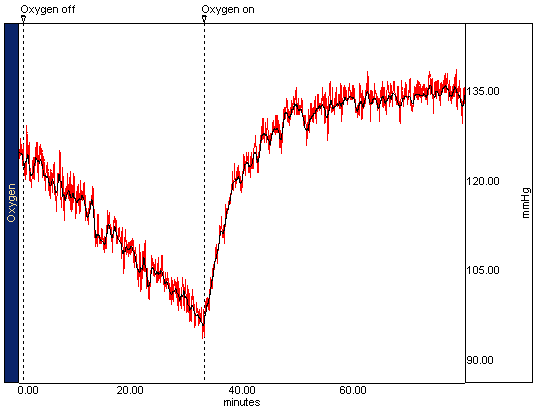A07 Fish Respiration & Q10

In this lesson, the Q10 principle is demonstrated by measuring the metabolic rate of goldfish at two different temperatures: 22° C (acclimation temperature) and 32° C (acute exposure temperature). The fish are placed in a sealed metabolic chamber with a known amount of oxygen that will decline as the fish consumes it over time (~30 min). Temperature of the water in the chamber is controlled using a water bath. Changes in oxygen levels are recorded using the BIOPAC MP30 System for later data analysis.
Experimental Objectives
-
Demonstrate the Q10 principle by measuring the metabolic rate of goldfish at two different temperatures: 22° C (acclimation temperature) and 32° C (acute exposure temperature).
-
Monitor the decline in a known amount of oxygen as the fish consumes it over time (~30 min.) in a sealed chamber of water at each temperature, using the BIOPAC Dissolved Oxygen Probe Transducer (SS69L).
-
Record the change using the BIOPAC MP30 System.
-
Measure the change in the partial pressure of oxygen (PO2) and use the solubility coefficient to calculate the change in content.
-
-
Calculate the oxygen consumption of the fish at the two different temperatures.
- Calculate the Q10 of fish acclimated to 22° C.
Tasks Performed by the Student
-
To calculate the Q10, the student will:
-
Measure metabolic rate (fall in PO2) at acclimation temperature
-
Expose the fish to an acute temperature change
-
Measure the metabolic rate (fall in PO2) at the acute exposure temperature
-
- Determine the mass of the fish
Videos
Biopac Student Lab Student Download
Student Prep & Distance Learning
Click the link(s) below for sample data and/or lesson procedure video(s), BSL PRO Lesson procedures (PDF) for human lessons*, and graph template files (*.gtl) for BSL PRO Lessons. If more than one .gtl is available, download the .gtl with the _suffix to match BSL version and hardware.
Lesson Hardware
This lesson requires a Biopac Student Lab (BSL) System and the following hardware. If your BSL System does not include all hardware items, expand your system by selecting required items below. For more details, review the Lesson: L# BSL Lessons - see the Lab Manual or launch BSL; A# and H# BSL PRO Lessons, click the PDF link above to review full setup, recording, and analysis procedures.
| Item | Name | Cart |
|---|---|---|
| SS69LA | Dissolved O2 Probe Transducer - MP3X/46/45 | Add to Cart |
| SS8L | Temp., Liquid immersion, BSL | Add to Cart |
Stay Connected